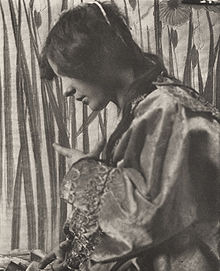
Gia Marie Carangi was an American model, considered by many to be the first supermodel. She was featured on the cover of numerous magazines, including multiple editions of Vogue and Cosmopolitan, and appeared in advertising campaigns for fashion houses such as Armani, Dior, Versace and Yves Saint Laurent.

Pictorialism is an international style and aesthetic movement that dominated photography during the later 19th and early 20th centuries. There is no standard definition of the term, but in general it refers to a style in which the photographer has somehow manipulated what would otherwise be a straightforward photograph as a means of creating an image rather than simply recording it. Typically, a pictorial photograph appears to lack a sharp focus, is printed in one or more colors other than black-and-white and may have visible brush strokes or other manipulation of the surface. For the pictorialist, a photograph, like a painting, drawing or engraving, was a way of projecting an emotional intent into the viewer's realm of imagination.

Adolph Alexander Weinman was a German-born American sculptor and architectural sculptor.

Audrey Marie Munson was an American artist's model and film actress, considered to be "America's first supermodel." In her time, she was variously known as "Miss Manhattan", the "Panama–Pacific Girl", the "Exposition Girl" and "American Venus." She was the model or inspiration for more than twelve statues in New York City, and many others elsewhere. Munson appeared in four silent films, including unclothed in Inspiration (1915). She was one of the first American actresses to appear nude in a non-pornographic film.

Peter Cooper Hewitt was an American electrical engineer and inventor, who invented the first mercury-vapor lamp in 1901. Hewitt was issued U.S. patent 682,692 on September 17, 1901. In 1903, Hewitt created an improved version that possessed higher color qualities which eventually found widespread industrial use.

Arnold Genthe was a German-American photographer, best known for his photographs of San Francisco's Chinatown, the 1906 San Francisco earthquake, and his portraits of noted people, from politicians and socialites to literary figures and entertainment celebrities.

Laura Gilpin was an American photographer.

Karl Struss, A.S.C. was an American photographer and a cinematographer of the 1900s through the 1950s. He was also one of the earliest pioneers of 3-D films. While he mostly worked on films, such as F.W. Murnau's Sunrise: A Song of Two Humans and Charlie Chaplin's The Great Dictator and Limelight, he was also one of the cinematographers for the television series Broken Arrow and photographed 19 episodes of My Friend Flicka.

Gustav Kobbé was an American music critic and author, best known for his guide to the operas, The Complete Opera Book, first published (posthumously) in the United States in 1919 and the United Kingdom in 1922.

Clarence Hudson White was an American photographer, teacher and a founding member of the Photo-Secession movement. He grew up in small towns in Ohio, where his primary influences were his family and the social life of rural America. After visiting the World's Columbian Exposition in Chicago in 1893, he took up photography. Although he was completely self-taught in the medium, within a few years he was internationally known for his pictorial photographs that captured the spirit and sentimentality of America in the early twentieth century. As he became well known for his images, White was sought out by other photographers who often traveled to Ohio to learn from him. He became friends with Alfred Stieglitz and helped advance the cause of photography as a true art form. In 1906 White and his family moved to New York City in order to be closer to Stieglitz and his circle and to further promote his own work. While there he became interested in teaching photography and in 1914 he established the Clarence H. White School of Photography, the first educational institution in America to teach photography as art. Due to the demands of his teaching duties, his own photography declined and White produced little new work during the last decade of his life. In 1925 he suffered a heart attack and died while teaching students in Mexico City.

Alma Mater is a bronze sculpture by Daniel Chester French which is located on the steps of the Low Memorial Library on the campus of Columbia University, in the Morningside Heights neighborhood of Manhattan, New York City. French designed the statue in 1901, and it was installed in September 1903. It is a personification of the alma mater, which represents Columbia in its role as an educational institution; since its installation, the statue has become closely associated with the image of the university.

Anne Wardrope Brigman was an American photographer and one of the original members of the Photo-Secession movement in America.
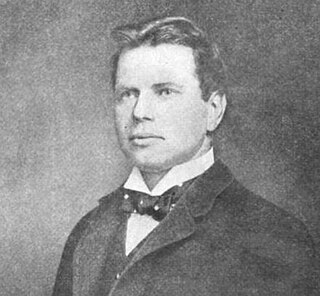
Schuyler Skaats Wheeler was an American electrical engineer and manufacturer who invented the electric fan, an electric elevator design, and the electric fire engine. He is associated with the early development of the electric motor industry, especially to do with training the blind in this industry for gainful employment. He helped develop and implement a code of ethics for electrical engineers and was associated with the electrical field in one way or another for over thirty years.
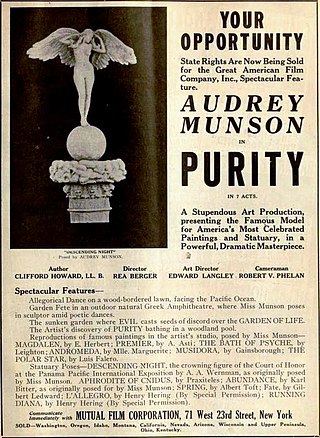
Purity is a 1916 American silent drama film, directed by Rae Berger and starring Audrey Munson, an artist's model who posed for many statues in New York City and the 1915 San Francisco Panama–Pacific International Exposition. The film's plot was written by Clifford Howard, art direction was by Edward Langley, and choreography was by Geneva Driscoll. The film's nude scenes caused it to be banned and preached against in some towns.
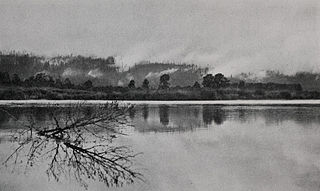
Sarah Hall Ladd was an early 20th-century American pictorial and landscape photographer.

Edmond Thomas Quinn was an American sculptor and painter. He is best known for his bronze statue of Edwin Booth as Hamlet, which stands at the center of Gramercy Park in New York City. His larger-than-lifesize bronze bust of Victor Herbert stands near The Pond in Central Park, New York City.
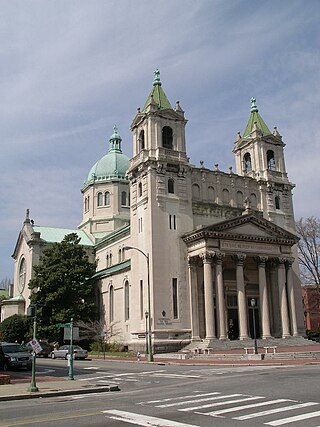
Joseph Hubert McGuire was an American architect practicing in New York City, where he specialized in Catholic churches and institutions. According to his headstone, McGuire was born January 21, 1865, although all other sources indicate 1866.

Bruno Louis Zimm was an American sculptor. He created a variety of works: fountains, memorials, freestanding sculptures, and architectural sculptures.
Isolde Brielmaier is an American curator and scholar working in New York City.
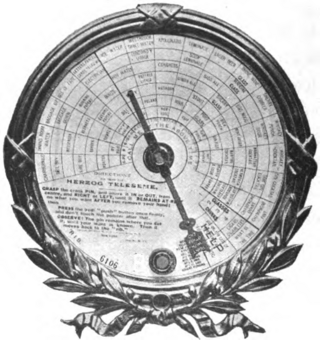
The teleseme, also known as the Herzog Teleseme, was an electric signaling device used in luxury hotels in the late 19th and early 20th centuries. Guests desiring room service could use the dial mechanism of their room's teleseme to indicate a good or service from over 100 options. An attendant in a hotel office would then receive the request at a corresponding teleseme and have the order filled.


